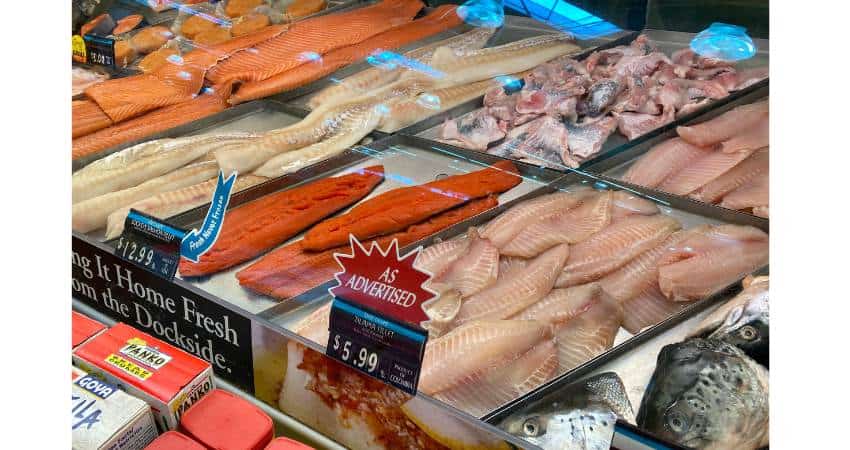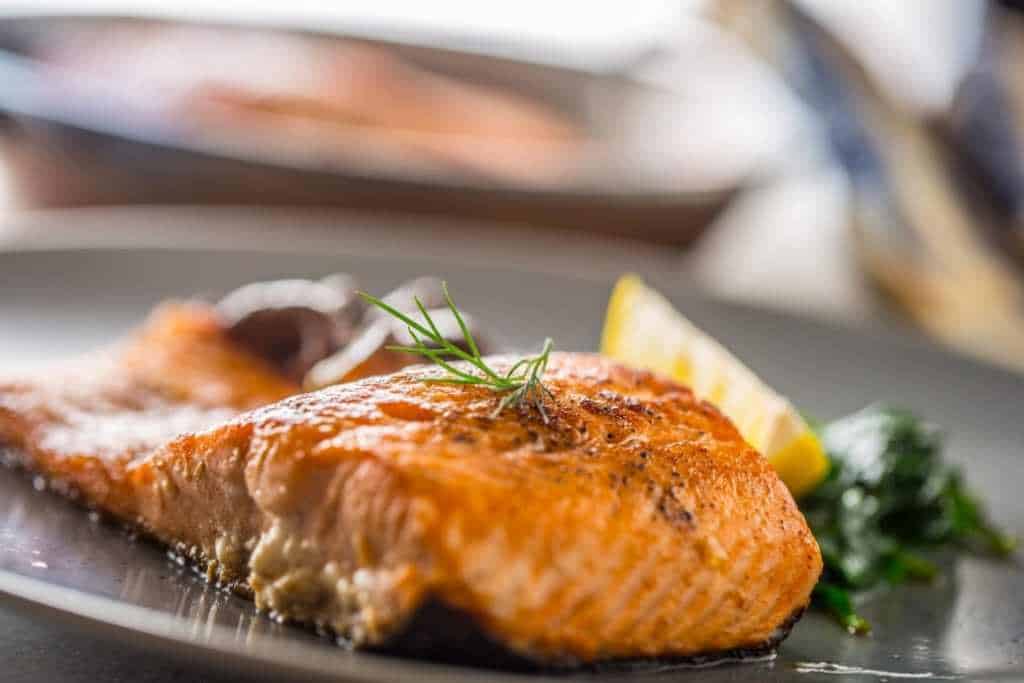Coho Salmon vs King: What’s The Difference?
King and Coho salmon are both great for high-quality meals, but it’s important to understand their differences.
King and Coho salmon vary in size, flavor, and color, making them easy to distinguish from one another. King salmon has a more intense flavor profile, a darker meat color and grows larger in comparison. Coho salmon is mildly flavored, grows up to 12 pounds and has light red meat.
There are a few qualities that really set King and Coho fish apart from one another. This article will compare their nutrients side-by-side and examine their tastes, textures, costs, mercury levels and if one can substitute for the other. Let’s explore these differences below.
Coho and King Salmon Taste
As a Certified Health Coach many clients ask me about food comparisons including salmon. I purchase and consume salmon every week. Therefore, I have researched this topic in the past and present. Let’s examine them closely.

King salmon is known for its intense flavor profile whereas the Coho salmon has a much more mild flavor profile in comparison. The King salmon has a higher fat level, which is where the intense flavor derives from.
In fact, the King salmon has the highest fat content of all the salmon species. This is what makes the flavor of the King Salmon much more iconic than any other salmon variety.
For those that are not a big fan of intense salmon flavor, the Coho breed may be a better option for you. A common question that comes up, is Coho salmon good to eat?
Coho salmon is good to eat due to its lower oil and fat content which gives it a milder taste. Although the Coho’s flavor is milder than most other salmons, it’s still more flavorful than a mild white fish like cod or halibut.
My Own Poll and Taste Test at Home
I wanted to get the opinion of real people like you and me. Therefore, I wanted to conduct my own research and contacted my clients, readers and members of food groups I belong to. I asked them which salmon they preferred.
- 53% said they preferred the taste of coho.
- 34% said they preferred the taste of king.
- 13% said they had no preference, or it depended on their mood.
I set up a blind test taste at my home. I prepared both salmons the same way using the same seasonings. Three out of five people, 60% chose the coho salmon. They said the flavor was better.
Coho and King Salmon Color and Texture
The King Salmon is instantly recognizable by its deep red color while the Coho is known for its reddish-orange color. It’s important to note the colors of the fish can vary.
In some cases, King salmon can have a white flesh, but the Coho salmon is typically lighter in color compared to King salmon.
The texture of a King Salmon is known for having a “melt in your mouth” effect due to the tender flesh. In fact, when King salmon is cooked to medium-rare, some people have compared the center of the fish to custard.
The Coho salmon is more lean, but it still has a good amount of firmness and its oil content can be used in a variety of dishes. When Coho salmon is cooked, it’s a bit more firm than King salmon, but it still has medium flakes comparable to King salmon.
Coho and King Salmon Nutrition
Different salmon breeds have varying nutrition labels and there is no exception to the King and Coho salmon breeds. Take a look at the following tables to see the nutritional difference between a 4 oz. King and 4 oz. Coho salmon.
| Nutrient | King Salmon, raw (4 Ounces) | Coho Salmon, raw(4 Ounces) |
| Calories | 212 | 166 |
| Fat | 13 g | 6.7 g |
| Saturated Fat | 2.1 g | 1.4 g |
| Cholesterol | 69 mg | 51 g |
| Protein | 23 g | 25 g |
| Omega-3 | 1.45 g | 1.49 g |
| B-6 | 0.3 mg | 0.6 mg |
| B-12 | 8.3 mcg | 4.7 mcg |
| Thiamin | 0.18 mg | 0.12 mg |
| Riboflavin | 0.19 mg | 0.15 mg |
| B5 | 1.1 mg | 0.9 mg |
| Iron | 0.9 mg | 0.6 mg |
| Niacin | 9.5 mg | 8.1 mg |
| Folate | 17.0 mcg | 10.2 mcg |
| Potassium | 419 mg | 479 mg |
| Magnesium | 27 mg | 35 mg |
| Phosphorus | 235 mg | 297 mg |
| Calcium | 47.6 mg | 40.8 mg |
| Zinc | 0.5 mg | 0.4 mg |
| Selenium | 35.2 mcg | 41.4 mcg |
According to the above table, King and Coho salmon have similar nutritional value. Let’s examine which one is better.
Coho salmon is slightly better than King due to its less total fat and unhealthy saturated fats even though they have a similar number of omega-3 fatty acids. Coho contains less calories and cholesterol than King salmon. Coho salmon contains more protein, B6, potassium, magnesium, phosphorus and selenium than King.
That being said, both of these fish breeds are considered to be very healthy and can be incorporated into most diets. King is no slouch and contains a wide variety of nutrients3.
King salmon contains more of the B vitamins like B12, thiamin, riboflavin, B5, folate and niacin. In addition, King provides more iron and calcium. Both fish contain similar amounts of zinc and the all important omega-3 fatty acids.
The main reason why Coho, King and other salmon out performs most fish is the high percentage of heart-healthy omega-3 fatty acids. Omega-3s help lower the risk of heart attack, stroke, high blood pressure and several other heart-related issues ((National Center for Biotechnology: Marine Omega-3 Supplementation and Cardiovascular Disease)).
This is primarily because omega-3s keep the arteries strong and healthy. They also help keep bad cholesterol levels low4.
Whichever of the two fish you pick, you’ll gain a good number of healthy nutrients5.
I wrote another article comparing two other salmon powerhouses, Keta and Sockeye. Check it out here, Keta vs Sockeye Salmon: What’s The Difference?
Coho and King Salmon Prices
If you have ever been in the supermarket for seafood, you have probably seen King salmon with an extremely high price tag. I’ve seen a 12 pack of 6 oz. King Salmon priced at $219.95 (about $18 per piece).
The reason for this high price is due to its high demand and how difficult it is to catch the fish. Since King salmon are so popular, there are laws and regulations to keep the breed from being overfished, which makes the price of King salmon skyrocket.
On the other hand, Coho salmon is slightly more affordable per oz. For an 8 oz. pouch of Coho salmon, expect to pay approximately $19.95. Even though the price is a bit lower in comparison to King Salmon, Coho is still a great quality fish.
The price of Coho or King salmon can vary depending on the run of the salmon and whether they were farm-raised or caught in the wild.
I visited and checked my local shoprite supermarket and found Coho but not king. This was the price of Coho:
- Wild Coho fillet
- $19.99 per pound
I checked FreshDirect and found the price for Coho and King salmon:
- Wild Coho fillet
- $19.99 per pound
- Farm-raised King salmon fillet
- $29.99 per pound

Coho and King Salmon Availability
Generally speaking, Coho and King salmon are wild-caught fish breeds. You can catch the King species in Alaska or you can purchase the salmon from your local grocery store (fresh or frozen) year-round.
Although it might be easy to hunt down fresh King salmon all year, the fresh Coho breed might not be as easy to find in your local fish market.
The Coho salmon can be found in the frozen section of stores all year, but the fresh meat is only available from June to October.
However, some farms raise both Coho and King salmon, although there are only a small number of farms allowed to raise King Salmon. This means you can still purchase farm-raised King and Coho salmon all year-round.
Consuming Coho and King Salmon

You can eat Coho or King salmon raw, or you can cook them in the oven, smoker or grill. No matter how you may choose to eat it, there are a few things to look out for to ensure your King salmon is safe to eat. Taking these precautions will help you avoid health risks like tapeworm.
If you decide to eat King salmon raw, it would be best to freeze the fish at -4 degrees Fahrenheit for several days or -31 degrees Fahrenheit for below 15 hours.
There is always some risk involved when eating seafood raw, even it has been frozen. However, if you freeze the fish, you reduce the risk of contracting parasites.
If you decide to cook your salmon, be sure to cook it until it is flakey, opaque and has an internal temperature of 145 degrees Fahrenheit. It is recommended to consume salmon once it has been cooked because this is the safest way to consume any type of seafood.
Coho and King Salmon: Substitutions
How about substituting one fish for the other? Sometimes one fish cannot be found, or you may already have one kind of fish but wasn’t called for in a recipe.
Coho salmon and King salmon can substitute for each other when cooking seafood, although they have different textures and tastes. They both can be cooked using the same methods like pan-fried, slow-roasted, poached, baked or searing in a pan.
King salmon may not be as good for grilling. Coho’s firmer texture will hold up good when grilling. When substituting Coho for King, certain sauces that go well with an oily fish like King salmon won’t go as well with Coho6.
When substituting Coho or King salmon, try following these tips:
- Match the weight and size of the fish according to the recipe.
- Always try choosing the same type of fillet cut, whole or cross section.
- When grilling a firmer texture, like Coho is more important.
- Choose skinless or skin as per the recipe.
If you have any questions to ask me about this article don’t hesitate to comment below or email us. You can find an email on our contact page.
Read Next – More Salmon vs Fish Articles!
Atlantic vs Pacific Salmon: What’s The Difference?
Salmon Oil vs Fish Oil: Which Is Better?
Sea Bass vs. Salmon: Which Is Better?
Pink vs Red Salmon: What’s The Difference?
Atlantic vs Wild Salmon: Which Is Better?
Pink vs Red Salmon: What’s The Difference?
Sardines vs Salmon: A Complete Comparison
- Nutrition Value: Fish, raw, wild, coho, salmon [↩]
- Nutrition Value: Fish, raw, (Alaska Native), king (chinook), salmon [↩]
- USDA: Chinook King Salmon [↩]
- National Center for Biotechnology Information: Benefits of salmon eating on traditional and novel vascular risk factors in young, non-obese healthy subjects [↩]
- USDA: Fish, salmon, coho, wild, cooked, moist heat [↩]
- Sea Grant North Carolina: Fish Flavors and Substitutions [↩]
